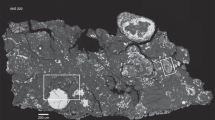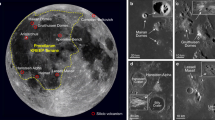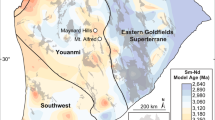Abstract
Unlike the other terrestrial planets, Earth has a substantial silica-rich continental crust with a bulk andesitic composition. A small number of meteorites with andesitic bulk compositions have been identified that are thought to be the products of partial melting of chondritic protoliths, a mode of petrogenesis distinct from that of Earth’s continental crust. Here we show, using geochemical analyses, that unlike other known andesitic meteorites, Erg Chech 002 has strongly fractionated and low abundances of the highly siderophile elements and mineralogy consistent with origin from a melt. The meteorite’s bulk composition, which is similar to terrestrial andesites, cannot be explained by partial melting of basaltic lithologies and instead requires a metal-free chondritic source. We argue that Erg Chech 002 probably formed by ~15–25% melting of the mantle of an alkali-undepleted differentiated asteroid. Our findings suggest that extensive silicate differentiation after metal–silicate equilibration of chondritic parent bodies was already occurring within the first 2.25 million years of Solar System history and that andesitic crust formation does not necessarily require plate tectonics.
This is a preview of subscription content, access via your institution
Access options
Access Nature and 54 other Nature Portfolio journals
Get Nature+, our best-value online-access subscription
$29.99 / 30 days
cancel any time
Subscribe to this journal
Receive 12 print issues and online access
$259.00 per year
only $21.58 per issue
Buy this article
- Purchase on Springer Link
- Instant access to full article PDF
Prices may be subject to local taxes which are calculated during checkout



Similar content being viewed by others
Data availability
All data in this study are available as online supplementary tables included with the manuscript. Supplementary Data 1 and 2 are also available on the EarthChem database (submission ID 2326).
References
Rudnick, R. L. & Gao, S. in Treatise on Geochemistry Vol. 3 (ed. Rudnick, R. L.) 1–51 (Elsevier, 2014).
Campbell, I. H. & Taylor, S. R. No water, no granites—no oceans, no continents. Geophys. Res. Lett. 10, 1061–1064 (1983).
Day, J. M. D. et al. Early formation of evolved asteroidal crust. Nature 457, 179–182 (2009).
Srinivasan, P. et al. Silica-rich volcanism in the early Solar System dated at 4.565 Ga. Nat. Commun. 9, 3036 (2018).
Collinet, M. & Grove, T. L. Widespread production of silica- and alkali-rich melts at the onset of planetesimal melting. Geochim. Cosmochim. Acta 277, 334–357 (2020).
Peucker-Ehrenbrink, B. & Jahn, B.-M. Rhenium–osmium isotope systematics and platinum group element concentrations: loess and the upper continental crust. Geochem. Geophys. Geosyst. 2, 2001GC000172 (2001).
Mittlefehldt, D. W., McCoy, T. J., Goodrich, C. A. & Kracher, A. Non-chondritic meteorites from asteroidal bodies. Rev. Mineral. Geochem. 36, 4-1–4-195 (1998).
Barrat, J.-Af et al. A 4,565-My-old andesite from an extinct chondritic protoplanet. Proc. Natl Acad. Sci. USA 118, e2026129118 (2021).
Bischoff, A. et al. Trachyandesitic volcanism in the early Solar System. Proc. Natl Acad. Sci. USA 111, 12689–12692 (2014).
Hahn, T. M. Jr, Lunning, N. G., McSween, H. Y. Jr, Bodnar, R. J. & Taylor, L. A. Dacite formation on Vesta: partial melting of the eucritic crust. Meteorit. Planet. Sci. 52, 1173–1196 (2017).
Agee, C. A., Habermann, M. A. & Ziegler, K. Northwest Africa 11575: unique ungrouped trachyandesite achondrite. 49th Lunar and Planetary Science Conference contrib. 2083 abstr. 2226 (2018).
Chekol, T. A., Kobayashi, K., Yokoyama, T., Sakaguchi, C. & Nakamura, E. Timescale of magma differentiation from basalt to andesite beneath Hekla Volcano, Iceland: constraints from U-series disequilibria in lavas from the last quarter millennium flow. Geochim. Cosmochim. Acta 75, 256–283 (2011).
Day, J. M. D. et al. Origin of felsic achondrites Graves Nunataks 06128 and 06129, and ultramafic brachinites and brachinite-like achondrites by partial melting of volatile-rich primitive parent bodies. Geochim. Cosmochim. Acta 81, 94–128 (2012).
Gardner-Vandy, K. G., Lauretta, D. S. & McCoy, T. J. A petrologic thermodynamic and experimental study of brachinites: partial melt residues of an R chondrite-like precursor. Geochim. Cosmochim. Acta 122, 36–57 (2013).
Collinet, M. & Grove, T. L. Formation of primitive achondrites by partial melting of alkali-undepleted planetesimals in the inner solar system. Geochim. Cosmochim. Acta 277, 358–376 (2020).
Gattacceca, J., McCubbin, F. M., Bouvier, A. & Grossman, J. N. The meteoritical bulletin, no. 109. Meteorit. Planet. Sci. 56, 1626–1630 (2020).
Kitts, K. & Lodders, K. Survey and evaluation of eucrite bulk compositions. Meteorit. Planet. Sci. 33, A197–A213 (1998).
Keil, K. Angrites, a small but diverse group of ancient, silica-undersaturated volcanic-plutonic mafic meteorites, and the history of their parent asteroid. Chem. der Erdie 72, 191–218 (2012).
Day, J. M. D., Walker, R. J., Qin, L. & Rumble, D. III Late accretion as a natural consequence of planetary growth. Nat. Geosci. 5, 614–617 (2012).
Riches, A. J. V. et al. Rhenium–osmium isotope and highly-siderophile-element abundance systematics of angrite meteorites. Earth Planet. Sci. Lett. 353–354, 208–218 (2012).
Shirey, S. B. & Walker, R. J. The Re–Os isotope system in cosmochemistry and high-temperature geochemistry. Annu. Rev. Earth Planet. Sci. 26, 423–500 (1998).
Hyde, B. C. et al. Characterization of weathering and heterogeneous mineral phase distribution in brachinite Northwest Africa 4872. Meteorit. Planet. Sci. 49, 1141–1156 (2014).
Putrika, K. Clinopyroxene + liquid equilibria to 100 kbar and 2450 K. Contrib. Mineral. Petrol. 135, 151–163 (1999).
Day, J. M. D. Metal grains in lunar rocks as indicators of igneous and impact processes. Meteorit. Planet. Sci. 55, 1793–1807 (2020).
Yoshino, T., Walter, M. J. & Katsura, T. Core formation in planetesimals triggered by permeable flow. Nature 422, 154–157 (2003).
Ghanbarzadeh, S., Hesse, M. A. & Prodanovic, M. Percolative core formation in planetesimals enabled by hysteresis in metal connectivity. Proc. Natl Acad. Sci. USA 114, 13406–13411 (2017).
Yamaguchi, A. et al. Experimental evidence of fast transport of trace elements in planetary basaltic crusts by high temperature metamorphism. Earth Planet. Sci. Lett. 368, 101–109 (2013).
Puchtel, I. S., Walker, R. J., James, O. B. & Kring, D. A. Osmium isotope and highly siderophile element systematics of lunar impact melt breccias: implications for the late accretion history of the Moon and Earth. Geochim. Cosmochim. Acta 72, 3022–3042 (2008).
Lunning, N. G. et al. Partial melting of oxidized planetesimals: an experimental study to test the formation of oligoclase-rich achondrites Graves Nunatak 06128 and 06129. Geochim. Cosmochim. Acta 214, 73–85 (2017).
Touboul, M., Sprung, P., Aciego, S. M., Bourdon, B. & Kleine, T. Hf–W chronology of the eucrite parent body. Geochim. Cosmochim. Acta 156, 106–121 (2015).
Kruijer, T. S. et al. Hf–W chronometry of core formation in planetesimals inferred from weakly irradiated iron meteorites. Geochim. Cosmochim. Acta 99, 287–304 (2012).
Day, J. M. D. et al. Differentiation processes in FeO-rich asteroids revealed by the achondrite Lewis Cliff 88763. Meteorit. Planet. Sci. 50, 1750–1766 (2015).
Day, J. M. D., Corder, C. A., Assayag, N. & Cartigny, P. Ferrous oxide-rich asteroid achondrites. Geochim. Cosmochim. Acta 266, 544–567 (2019).
Gardner-Vandy, K. G. et al. The Tafassasset primitive achondrite: insights into initial stages of planetary differentiation. Geochim. Cosmochim. Acta 85, 142–159 (2012).
Le Bas, M. J., Le Maitre, R. W., Streckeisen, A. & Zanettin, B. A chemical classification of volcanic rocks based on the total alkali–silica diagram. J. Petrol. 27, 745–750 (1986).
Warren, P. H. & Gessler, N. Northwest Africa 2191, an extraordinarily evolved eucrite. 51st Lunar and Planetary Science Conference abstr. 2446 (2020).
McDonough, W. F. & Sun, S. S. The composition of Earth. Chem. Geol. 120, 223–253 (1995).
Tait, K. T. & Day, J. M. D. Chondritic late accretion to Mars and the nature of shergottite reservoirs. Earth Planet. Sci. Lett. 494, 99–108 (2018).
Cohen, A. S. & Waters, F. G. Separation of osmium from geological materials by solvent extraction for analysis by thermal ionization mass spectrometry. Anal. Chim. Acta 332, 269–275 (1996).
Birck, J. L., Roy Barman, M. & Capmas, F. Re–Os isotopic measurements at the femtomole level in natural samples. Geostand. Newsl. 20, 19–27 (1997).
Day, J. M. D., Brandon, A. D. & Walker, R. J. Highly siderophile elements in Earth, Mars, the Moon, and asteroids. Rev. Mineral. Geochem. 81, 161–238 (2016).
Rahib, R. R. et al. Mantle source to near-surface emplacement of enriched and intermediate poikilitic shergottites in Mars. Geochim. Cosmochim. Acta 266, 463–496 (2019).
McIntosh, E. C., Day, J. M. D., Liu, Y. & Jiskoot, C. Examining the compositions of impactors striking the Moon using Apollo impact melt coats and anorthositic regolith breccia meteorites. Geochim. Cosmochim. Acta 274, 192–210 (2020).
Acknowledgements
This work was funded by the NASA Emerging Worlds programme award (NNX16AR95G) to J.M.D.D.
Author information
Authors and Affiliations
Contributions
The project was conceived by J.M.D.D. and K.G.G.-V. K.G.G.-V. acquired the piece of EC 002 used in this study. Bulk rock analyses were performed by J.M.D.D. EPMA analyses were supervised by A.U. Petrography and LA-ICP-MS analyses were performed by R.W.N. The initial manuscript was written by R.W.N. and edited by other co-authors. Funding was acquired by J.M.D.D.
Corresponding author
Ethics declarations
Competing interests
The authors declare no competing interests.
Peer review
Peer review information
Nature Geoscience thanks Max Collinet, Maxwell Thiemens and the other, anonymous, reviewer(s) for their contribution to the peer review of this work. Primary Handling Editor: Tamara Goldin, in collaboration with the Nature Geoscience team.
Additional information
Publisher’s note Springer Nature remains neutral with regard to jurisdictional claims in published maps and institutional affiliations.
Supplementary information
Supplementary Information
Supplementary Tables 1–5 and Figs. 1–7.
Supplementary Data 1
All in situ major-element data.
Supplementary Data 2
All in situ trace-element data.
Rights and permissions
Springer Nature or its licensor holds exclusive rights to this article under a publishing agreement with the author(s) or other rightsholder(s); author self-archiving of the accepted manuscript version of this article is solely governed by the terms of such publishing agreement and applicable law.
About this article
Cite this article
Nicklas, R.W., Day, J.M.D., Gardner-Vandy, K.G. et al. Early silicic magmatism on a differentiated asteroid. Nat. Geosci. 15, 696–699 (2022). https://doi.org/10.1038/s41561-022-00996-1
Received:
Accepted:
Published:
Issue Date:
DOI: https://doi.org/10.1038/s41561-022-00996-1
This article is cited by
-
Crustal remelting origin of highly silicic magmatism on the Moon
Communications Earth & Environment (2023)



